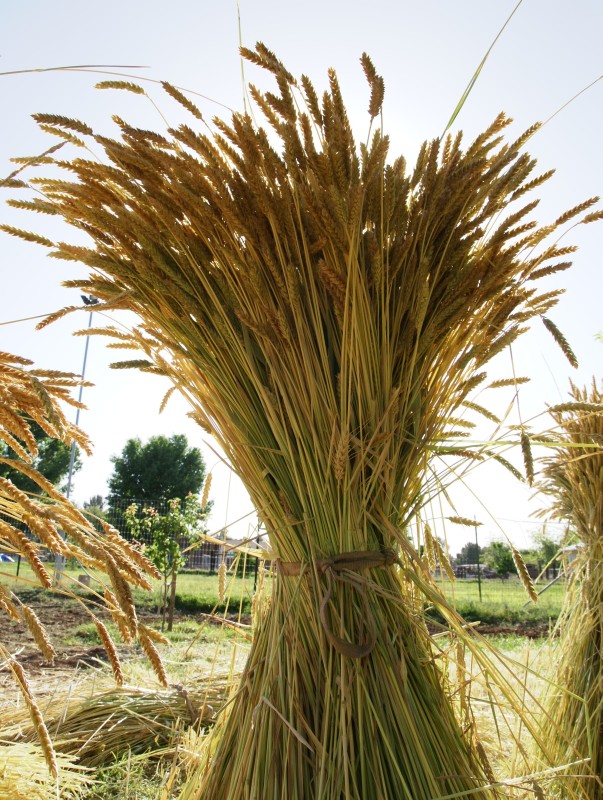In this post, you can learn some more about the wheat we planted Thursday, November 29nd.
The three large beds which we planted contained Sonora, Red Fife and Glenn seed. The seed was generously donated by Glenn Roberts, of Anson Mills in South Carolina.
This post will focus on Sonora.
Sonora is a soft white winter wheat and what is called a "Landrace" grain, meaning it is (or historically was) a local variety of wheat that developed naturally by farmer selection and environmental adaptation. This is opposed to "Modern" wheats, which are the result of very deliberate and scientific, selective breeding.
The glutinous white flour made from Sonora wheat makes stretchable dough suited to large tortillas, which were historically important for the development of burritos and chimichangas. Its wheat berries were used for pinole and posole. Its growing area is primarily associated with the bi-national Sonoran Desert and Mediterranean California climes.

The three large beds which we planted contained Sonora, Red Fife and Glenn seed. The seed was generously donated by Glenn Roberts, of Anson Mills in South Carolina.
This post will focus on Sonora.
Sonora is a soft white winter wheat and what is called a "Landrace" grain, meaning it is (or historically was) a local variety of wheat that developed naturally by farmer selection and environmental adaptation. This is opposed to "Modern" wheats, which are the result of very deliberate and scientific, selective breeding.
The glutinous white flour made from Sonora wheat makes stretchable dough suited to large tortillas, which were historically important for the development of burritos and chimichangas. Its wheat berries were used for pinole and posole. Its growing area is primarily associated with the bi-national Sonoran Desert and Mediterranean California climes.
Early documentation indicates White Sonora wheat was among the most disease, drought tolerant and rust resistant varieties in the New World, with a record of quality production stretching from South America to the upper American Midwest. It was capable of producing an excellent crop with no irrigation and little fertility when compared with modern wheat. A Wisconsin farming journal from the 1870s details a Sonora harvest with a per-acre yield rivaling the best modern wheat. Although irrigation boosts Sonora yields, the wheat is remarkably drought tolerant and matures in areas where early, light rainfall and hot, dry climates are the norm—with no irrigation at all.
Slow Food USA gives a great description of the history of this wheat variety.
History of Sonora
"White Sonora wheat is one of the oldest surviving wheat varieties anywhere in North America. Predating the Red Fife [which we are also growing!] and Turkish Red wheat, White Sonora is a soft, round-grained winter wheat with pale red grains that grow on beardless heads.
The earliest records document its existence in the mountain plains of Sonora, Mexico in early 1700 but the wheat surely predates that era by generations. It was widely planted in California by the early 1800s. Up through the Civil War, this wheat variety provided most West Coast residents with their flour and during the war it nourished nearly all troops, on both sides, west of the Mississippi.
Sonora, along with Defiance and Austrialian wheats and landrace barley, comprised the majority of production by 1880 in California’s Central Valley, where 2,750,000 acres of wheat were grown, the largest wheat enterprise in history at that time, setting floor prices on the London International Wheat Exchange. Commercial production of Sonora wheat in the Central Valley was in decline by the 19th century, surviving into the 1950s but in much reduced area. Since then, it has not been used in commercial production anywhere on the continent.
Norman Borlaug, the Nobel Prize-winning plant breeder, used White Sonora wheat as drought-adapted breeding material for the Sonora 64 variety, one of the first Green Revolution wheats. Unfortunately, the development of this super variety led to the commercial demise of White Sonora wheat between 1970 and 1980."

Sonora Today
"Today, the White Sonora wheat tradition persists in a few rural areas of northern Sonora, southern Arizona, and central California. Current production is very limited, but the variety is being grown on a few farms in California and the Southwest. Native Seeds/SEARCH and Sabores Sin Fronteras Foodways Alliance are working together to make 10-pound bags of wheat berries available to artisan bakers and tortilla makers in an effort to characterize its baking and taste qualities. The San Xavier Cooperative Association Farm in Tucscon, AZ and the Tohono O’doham tribe’s gift store also sell wheat berries to locals.
Monica Spiller, founder of Whole Grain Connection, a non-profit that supplies hard-to-find seeds and information to farmers, is working to recover White Sonora wheat production in California. She has devoted much of the last three decades to studying and growing wheat varieties historically grown in the region. She noticed that the older varieties like White Sonora have certain advantages for small organic farms, such as being naturally tall, and thus able to shade out weeds and reduce the need for herbicides.
White Sonora wheat production works well in synergy with cattle husbandry and can be grazed at least twice per season and still produce a gorgeous food crop. When milled to whole grain flour it produces light-colored tortillas and yeasted breads with a lovely texture."
As you can see, this grain is perfect for bread bakers and tortilla makers alike, and we are on the cutting edge in testing its growability in Los Angeles. Next, Red Fife...

No comments:
Post a Comment